#The Irish Army Reserve
Explore tagged Tumblr posts
Text
#OTD in 1957 – Death of Seán Sabhat and Feargal O'Hanlon; killed during a raid led by Sean Garland against an RUC Barracks in Brookeborough, Co Fermanagh.
Seán is mostly widely known as Seán South from Garryowen. There have even been several songs written to his honour under this misconception. In reality South was from O’Connell Avenue in Limerick, but due to the poetic license of Seán Costello also a Limerickman, he’ll forever be linked with Garryowen. Seán Sabhat, also known as Sean South, born in 1928, was shot down by the Royal Ulster…

View On WordPress
#An Fòrsa Cosanta Áitiúil#Border Campaign#Brookeborough#Co. Fermanagh#Dominic Behan#Feargal O&039;Hanlan#Flying IRA Column#IRA#Monaghan County Council#New Year&039;s Day#Pádraigín Uí Mhurchadha#RUC Barracks#Seán Garland#Seán Sabhat#Sinn Fein#The Irish Army Reserve#The Patriot Game
5 notes
·
View notes
Text
Hani (Fox)
BTS 8th Member

Background:
~Full Name: Hani O’Riordan (한이 오리오던)
~Stage Name: Fox
~Birthday: June 22, 1998
~Nationality: Irish-Korean
~Birthplace: Ireland
~Moved to Korea: When she was a baby, so she has spent most of her life in Korea.
~Family:
•Younger Brother: Currently attending college in America.
•Father: A professor.
•Mother: An artist who teaches art, specializing in painting and pottery.
~Languages: Fluent in Korean and English, with a soft Irish lilt when she speaks English.
~Heritage: Celebrates both Irish and Korean cultures, combining traditional Irish melodies with K-pop rhythms.
~Role in BTS: vocalist, dancer, and song writer
Personality:
~Creative and Playful: Loves to incorporate her Irish heritage into her music and performances.
~Intelligent and Strategic: Known for her quick wit and being a strategic thinker in games or challenges.
~Calm Under Pressure: Provides a grounding energy during intense rehearsals or tight schedules.
~Loyal and Protective: Fiercely protective of her BTS family.
~Warm and Mysterious: While she may initially appear reserved, she is deeply caring and supportive.
Appearance:
~Height: 167 cm (5’6”)
~Hair: Auburn, often styled in soft waves, giving her a striking, unique look that complements her Irish-Korean heritage.
~Eyes: Hazel-green, reflecting her Irish heritage.
~Style: Unique mix of modern and traditional Korean and Irish elements in her outfits.
~Stage Presence: Known for her captivating, mysterious stage persona with a sharp, intense gaze.
Talents:
~Singing: Rich, soulful voice with a slight rasp.
~Rapping: Occasionally delivers precise, impactful rap lines.
~Dancing: Known for her fluid, graceful dance style with flexibility and power. Grew up learning ballet.
~Instruments: Plays the piano.
~Songwriting: Incorporates personal experiences and cultural influences in her lyrics.
~Artistry: Influenced by her mother, Hani has an eye for visual aesthetics, and she enjoys painting and pottery in her spare time.
Quick Facts:
~Nicknames: “Fire Fox,” “Han”
~Favorite BTS Song: “Spring Day.”
~Hobbies: Hiking, painting (even though she’s not good), reading, and occasionally helping her mom with pottery.
~Favorite Food: Jjajangmyeon and Irish stew.
~Signature Move: Her “fox smile,” a mischievous grin she uses to tease the members.
~Fan Interaction: Engages with international ARMYs in both English and Korean during livestreams.
Relationships with Other Members:
~Namjoon: Intellectual conversations about books and philosophy.
~Jin: Shares a love for food and cooking, often talking about opening a restaurant together.
~Yoongi: Spends long hours in the studio with Yoongi, discussing deep topics.
~Hoseok: Her calm balances his bright energy.
~Jimin: Playful banter and intense dance rehearsals.
~Taehyung: Artistic collaborations and shared creative interests.
~Jungkook: They have a playful, competitive dynamic, frequently challenging each other in games and athletic activities. Jungkook is protective of her but enjoys teasing her since she’s the youngest.
Stage Persona:
On stage, Fox is enchanting and mysterious, with fluid movements and captivating eyes that draw the audience in. She brings an emotional depth to her performances, often weaving in her cultural influences.
———————————————————————————
#bts #bts8thmember #foxofbts #btsimagine #btsscenarios #kpop #RM #Namjoon #Suga #yoongi #jhope #hoseok #seokjin #jin #jungkook #v #taehyung #jimin #bangtan
#bts army#bts#jungkook#namjoon#rm#bts suga#yoongi#taehyung#jimin#jhope#jin#bts 8th member#foxofbts#bts scenarios
15 notes
·
View notes
Text
OC: Dustball Personnel File
Dustball ML

Name: ■■■■■■■ ■■■■■ ■■■■■■■■ Callsign: Dustball Birthplace: ■■■■■, ■■■■■, Northern Ireland Date of Birth: 1994 Citizenship: Republic of Ireland Martial Status: ■■■■■ # of dependents: ■■■■■ Education: Homeschool 1998-2012 Graduate Irish Baptist College 2012-2015 Graduate in Theology Languages: English (Native), Fula (Fluent), German (Basic)
𝕋𝔼ℂℍℕ𝕀ℂ𝔸𝕃 ℝ𝔼ℂ𝕆ℝ𝔻
Branch of Service: British Army Reserves (2012), SAS (2015) SAS Fitness test: Push-ups: Yes (+3pts) Sit-ups: Yes (+12pts) 2.5km Time: 7.01min Jump from 10M tower: Yes 25M water swim: Yes 200M swim/tread: yes Underwater Retrieval: Yes 13km hill run time: 55.12min Notes: enjoyed 10m tower the most Rank: Lieutenant (2021) Skills and Specializations: Hostage rescue Close quarter combat Information acquisition Sabotage Notes: Following ■■■■■, preferred location is inside ventilation recommended to engineering refused recommendation Too self aware
𝕄𝕖𝕕𝕚𝕔𝕒𝕝 ℝ𝕖𝕔𝕠𝕣𝕕𝕤
Injuries: Concussion '15, '16, '17, '18, '19, '20, '21, '22 No required Follow up Broken Bone '20, '22 Required Follow up, X-ray Bullet Wound '17, '19, '20 Required Follow up, Doctor visit Facial Wound '15 Required Follow up, Surgery Medication List: 15mg Morphine '15, '17, '19, '20, '22 10mg Cetirizine '19 - current
11 notes
·
View notes
Text


















The Duke of Edinburgh in his role as Colonel, 1st Battalion London Guards, attends a training exercise at Hankley Common on October 16, 2024 in Farnham, England.
The London Guards were formed (by bringing together 26 separate Volunteer Force battalions) in 1908 as The London Regiment before becoming The London Guards in 2021. The 1st Battalion London Guards are the Army Reserve for the Guards Division made up of reservists from The Grenadier, Coldstream, Scots, Welsh and Irish Guards.
#Prince Edward#Duke of Edinburgh#Prince Edward Duke of Edinburgh#Hankley Common#Farnham#England#London Guards Exercise#The Royal Family#The British Royal Family#British Royal Family#October 16th 2024
6 notes
·
View notes
Text
hellhound: a timeline

1985 - jonathan price is born at the tail-end of england’s autumn, just outside herefordshire.
1987 - a bright, bouncing baby joins the healy family in kildare, ireland. january snow welcomes them into the world.
1998 - healy moves into their grandfather’s house on a permanent basis after their parents are deemed unfit
2001 - price joins the british army infantry at 16 to escape his father and a difficult home life. he encourages his mother to move back to her family in liverpool. she does not.
2003 - healy runs over their granddad’s mailbox peeling out of the drive on a brand new license. price is shot for the very first time.
2004 - healy joins the irish army after meeting a recruiter outside a pub that they were kicked out of for fighting. again. their granddad packs biscuits in their bags when they leave for training.
2007 - a domestic terrorism scare in belfast causes the sas and arw to team up. young sergeant healy is tasked with guarding civilians, but takes off when they see the suspect making a run for it. lieutenant price follows and they tackle the suspect in a back alley, taking him alive. price calls healy a bloody hellhound when defending their actions against a court martial, and they adopt the moniker hound shortly after.
2008 - an international terrorist group flees to vienna, where a joint venture between england, ireland, and austria attempts to capture its leader. former mi6 operative wesley martin is charged with acts of terror on english and irish soil, so the sas and arw lead the charge with austria’s unit waiting in the wings. martin flees the scene with the aid of a flashbang, and only price and hound are able to pursue. in the following altercation martin wounds price, attempts to flee once more, and is caught and killed by hound. hound then stitches price’s stomach closed in the field, saving his life but leaving a nasty scar. they part ways after. hound has a crush.
2010 - hound is promoted to lieutenant for saving their captain’s life on a difficult mission. they steal a coaster from his desk to commemorate the moment.
2011 - price’s father dies, and he flies home for a funeral where he does not cry, and helps lower a coffin into a gravesite he will not visit. he’s named captain just a week later.
2016 - price and hound meet again in egypt. price takes the brunt of a blow meant for hound and fractures his collarbone. they agree to keep in touch afterwards, sending the occasional text as proof of life and meeting for drinks on leave. both have thought about the other often over the years, and they fall into an easy friendship.
2019 - an attack is launched in picadilly circus, london, and price meets sgt. kyle garrick for the first time. together they aid farah karim, hadir karim, and alex keller in their quest to track down and neutralize stolen chemical gas from a raid in verdansk. hound is busy translating intel for the arw at the time, but when price asks them to join his task force later that year they accept without reservation.
2020 - simon “ghost” riley asks for backup he can trust in verdansk after a blown mission. price sends hound. several months later their knee is shot out when a mission goes south. price and ghost rush them to the nearest hospital. though difficult, the surgery is successful, and amidst fraught emotion price realizes that he loves hound. he does not tell them.
2021 - the situation in verdansk worsens. price keeps busy while hound undergoes intense physical therapy. they insist on helping sort through paperwork and translating intel after laswell suggests that an honorable discharge might be their best option.
2022 - hound is recovering after complications from a second surgery when general ghorbrani is assassinated and task force 141 is assigned to track down hassan zyani and several missing american bombs. they provide backup on comms as needed, filling in where laswell asks. not long after shadow company’s betrayal and the recovery of the stolen missiles in chicago, the 141 shifts its focus to makarov. hound is cleared for active duty and accompanies price on a black op in moscow. they interrogate one of makarov’s men. they plan to stage an ‘accident’, but when he threatens hound price shoots him point-blank. he and hound confess their feelings and sleep together for the first time. that christmas hound brings price home to their granddad, and soon after they convince him to get a flat together in kildare.
2023 - price is captured by makarov’s men after a mission goes sideways. hound and the rest of the 141 track him relentlessly, leading to his rescue from a not-so-abandoned gulag deep in the russian wilderness. hound tells price that they love him for the first time in the hospital afterwards. he doesn’t say it back until months later on a beautiful sunny day in a london park over leave, but they’ve both known all along.
2024 - price asks gaz to accompany him engagement ring shopping in london. after hours of searching they finally find the right one, and price proposes to hound just a few months later. gaz is asked to be the best man.
2025 - hound and price are married. they have a wonderful ceremony held in the church price grew up going to, though he’ll admit he never found much religion there until he saw hound walking towards him in white.
#fran writes#hellhound#WITNESS MY VISIONS 💥❤️🔥💯#i could include. so much more but i didn’t. you’re welcome.#also neatly sidestepped the latest game bc first of all i haven’t watched and second i heard it was ass lol#this is a healthy mix of canon and headcanon#and!! i included hound’s surname#it’s not like. ‘canon’ to anyone but me but it’s the name i used when i made them in fifa#jack ‘hound’ healy my special football boy ⚽️
8 notes
·
View notes
Text

"20th August 1695 - Assault on Namur Citadel
The siege of Namur began on 23rd June when the forces of King William III arrived before the town. Amongst his forces were Hamilton’s Regiment, the Royal Irish. The siege trenches were constructed by 28th June and the bombardment began. By 24th July, the French commander, Boufflers, evacuated the greater part of the city and moved his army into the citadel. William continued to pound the defences with 136 heavy guns and 58 mortars. During this part of the siege the Royal Irish had been with a force sent to draw away a French field army. By 10th August the regiment had returned to the siege and were back in the trenches. On the 19th William was ready to assault two breaches, the Coehoorn, to be attacked by the Bavarian infantry and the Terra Nova to be attacked by the British.
Lord Cutts commanded 700 grenadiers and 4 regiments of foot, one of which was Hamilton's. The latter were not in the first wave but were held in reserve. At 10am on 20th an explosion signalled the start of the attack. The grenadiers stormed up the Terra Nova breach, but were severely mauled and had to pull back. Lord Cutts and many others were wounded. It was now the turn of Hamilton's. They struggled over the many dead bodies of the grenadiers, and beyond, suffering many casualties as they went. Through sheer determination they reached the top of the breach and planted their Colours. Beyond they could see another defensive breastwork that was undamaged. The Royal Irish made a suicidal attempt to storm it and many of those killed that day fell in that part of the assault. They were forced to give up and retreat, being pushed well back by a French counter attack.
Meanwhile the Bavarians at the Coehoorn breach had fared equally badly and were desperately in need of reinforcement. Lord Cutts, although injured himself, gathered 200 men for a do-or-die charge to relieve their allies. Hamilton���s Regiment joined this attack and again lost many men but it was a success and the citadel was in their hands. King William had watched the regiment's progress and honoured them by officially conferring the title Royal Regiment of Ireland on them along with the motto Virtutis Naurcencis Praemium- The Reward for Valour at Namur. The regiment was also allowed emblazon the arms of the House of Nassau on its Colours. The regiment’s casualties on the day were 10 officers killed, 3 more died of wounds and 12 were wounded. The casualties for the other ranks were estimated at 86 killed and 185 wounded.
#18thfoot #royalirishregiment #namur
5 notes
·
View notes
Text
Events 12.29
1170 – Thomas Becket, Archbishop of Canterbury, is assassinated inside Canterbury Cathedral by followers of King Henry II; he subsequently becomes a saint and martyr in the Anglican Communion and the Catholic Church. 1503 – The Battle of Garigliano was fought between a Spanish army under Gonzalo Fernández de Córdoba and a French army commanded by Ludovico II, Marquess of Saluzzo. 1607 – According to John Smith, Pocahontas, daughter of Powhatan leader Wahunsenacawh, successfully pleads for his life after tribal leaders attempt to execute him. 1778 – American Revolutionary War: Three thousand British soldiers under the command of Lieutenant Colonel Archibald Campbell capture Savannah, Georgia. 1812 – USS Constitution, under the command of Captain William Bainbridge, captures HMS Java off the coast of Brazil after a three-hour battle. 1835 – The Treaty of New Echota is signed, ceding all the lands of the Cherokee east of the Mississippi River to the United States. 1845 – The United States annexes the Republic of Texas and admits it as the 28th state. 1860 – The launch of HMS Warrior, with her combination of screw propeller, iron hull and iron armour, renders all previous warships obsolete. 1874 – The military coup of Gen. Martinez Campos in Sagunto ends the failed First Spanish Republic and the monarchy is restored as Prince Alfonso is proclaimed King of Spain. 1876 – The Ashtabula River railroad disaster occurs, leaving 64 injured and 92 dead at Ashtabula, Ohio. 1890 – On Pine Ridge Indian Reservation, 300 Lakota are killed by the United States 7th Cavalry Regiment. 1911 – Mongolia gains independence from the Qing dynasty, enthroning 8th Jebtsundamba Khutughtu as Khagan of Mongolia. 1913 – Cecil B. DeMille starts filming Hollywood's first feature film, The Squaw Man. 1930 – Sir Muhammad Iqbal's presidential address in Allahabad introduces the two-nation theory and outlines a vision for the creation of Pakistan. 1934 – Japan renounces the Washington Naval Treaty of 1922 and the London Naval Treaty of 1930. 1937 – The Irish Free State is replaced by a new state called Ireland with the adoption of a new constitution. 1940 – In the Second Great Fire of London, the Luftwaffe fire-bombs London, England, killing almost 200 civilians during World War II. 1972 – Eastern Air Lines Flight 401 (a Lockheed L-1011 TriStar) crashes in the Florida Everglades on approach to Miami International Airport, Florida, killing 101 of the 176 people on board. 1975 – A bomb explodes at LaGuardia Airport in New York City, killing 11 people and injuring more than 75. 1989 – Czech writer, philosopher and dissident Václav Havel is elected the first post-communist President of Czechoslovakia. 1989 – The Nikkei 225 for the Tokyo Stock Exchange hits its all-time intra-day high of 38,957.44 and closing high at 38,915.87, serving as the apex of the Japanese asset price bubble. 1992 – Fernando Collor de Mello, president of Brazil, tries to resign amidst corruption charges, but is then impeached. 1994 – Turkish Airlines Flight 278 (a Boeing 737-400) crashes on approach to Van Ferit Melen Airport in Van, Turkey, killing 57 of the 76 people on board. 1996 – Guatemala and leaders of Guatemalan National Revolutionary Unity sign a peace accord ending a 36-year civil war. 1998 – Leaders of the Khmer Rouge apologize for the Cambodian genocide that claimed over one million lives. 2003 – The last known speaker of Akkala Sami dies, rendering the language extinct. 2006 – The UK settles its Anglo-American loan, post-WWII loan debt. 2013 – A suicide bomb attack at the Volgograd-1 railway station in the southern Russian city of Volgograd kills at least 18 people and wounds 40 others. 2013 – Seven-time Formula One champion Michael Schumacher suffers a massive head injury while skiing in the French Alps. 2020 – A large explosion at the airport in the southern Yemeni city of Aden kills at least 22 people and wounds 50.
2 notes
·
View notes
Text


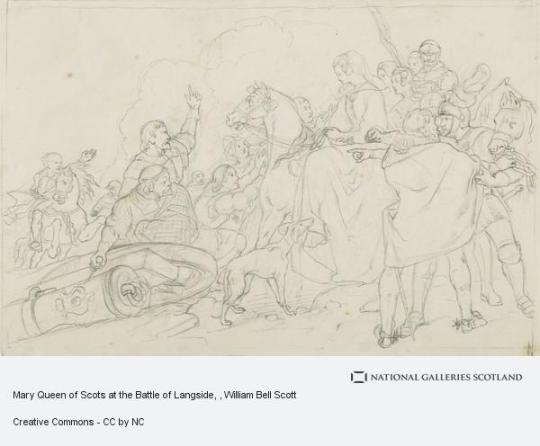
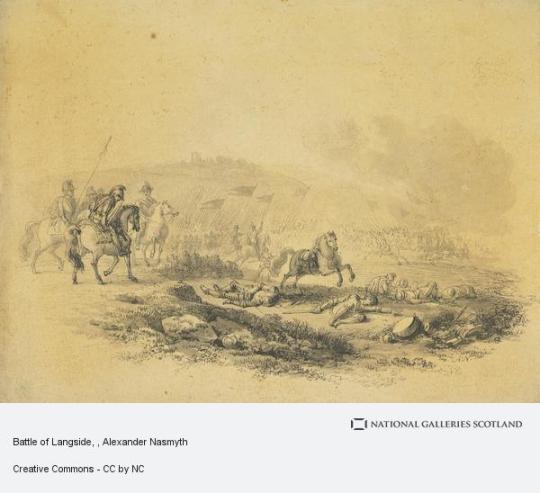
DavysStreams
@davysstreams
A Tumblr blog for my streams, Sports, TV Shows and Movies, give me a shout if you want anything posted.
Blog settingsAsk me anythingFollowing
Posts
Pinned Post
davysstreams
Jan 18, 2022

If you don’t want to miss a game why not go for an IPTV set up. DM @Gabbo1980 on Twitter, and mention my name, you get ALL the games and more the costs just £10 a month or £70 for a full year, it is the way forward and in my eyes a bargain. You’ll need an Android box or better still a Amazon Firestick, which costs around £30, but you wont regret it. Some TV’s have also got Android on them nowadays. As well as sports you get loads of other stuff, all the Sky Cinema channels, documentaries, kids channels, channels from around the world including Irish TV channels, USA Movies, if you were paying for this through Sky, BT, Virgin etc it would be over £100 per month.
4 notes
davysstreams
4m ago
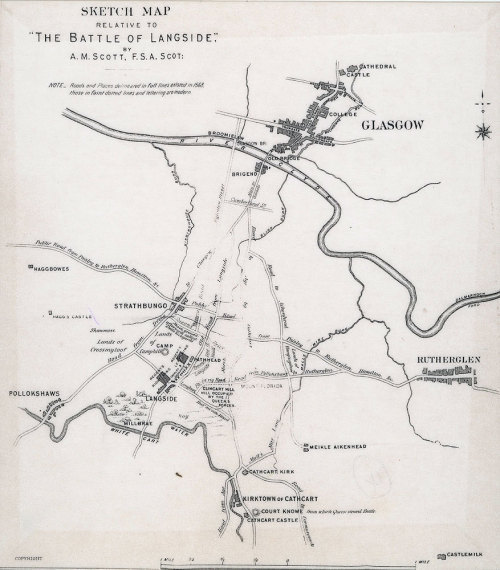



May 13th 1568 saw the Battle of Langside.
The army under King James VI name was under the command of the Regent and Mary’s half brother James Stewart, Earl of Moray whilst his deputy and commander of the vanguard was James Douglas, Earl of Morton. The army consisted of troops hastily assembled but included some experienced soldiers - notably William Kirkcaldy of Grange. Furthermore the Regent’s cause was widely supported amongst the Scottish nobility, many of whom had profited from the Reformation not least from the cheap acquisition of former church lands.
The Queen’s army, whilst nominally headed by the Mary, was under the military command of Archibald Campbell, Earl of Argyll. It included a number of a notable magnates amongst them the Earls of Eglinton, Casselis and Rothes.
With The Earl of Morton in command of his main force, Moray appointed Kirkcaldy to have ‘special care as an experimented captain to oversee every danger‘. Kirkcaldy took two hundred hagbutters “musketeers” forward to occupy cottages on each side of Long Loan, where garden walls offered protection from cannon fire, and he reserved two hundred pikemen and cavalry on the west side of the village.
Realising the danger, Mary sent Maitland to negotiaite with Moray, but the Hamilton’s were spoiling for a fight and jumped the gun. Kirkcaldy rode from wing to wing to supervise the defences, while the twenty-five-year-old Lord Claud Hamilton advanced with Mary’s main army of 2,000 men supported by and George, 5th Lord Seton’s cavalry. They stormed into Long Loan, where Kirkcaldy picked them off easily with his hagbutters backed by Ker of Cessford and Home, on foot with pike in hand, leading his six hundred spearmen. Mary’s troops fought their way forward bravely despite the cost, and almost turned Moray’s right flank, but Kirkcaldy, ever vigilant, saw the danger. He called up the rear-guard led by Sir William Douglas and Lindsay as reinforcement.
Kirkcaldy had orders from Moray to minimise bloodshed, and his forces struck the enemy on their flanks and faces, throwing them into confusion. Mary’s van needed support from the main body of her troops under Argyll, but it is said that at this critical moment he fainted, possibly with an epileptic fit, and the leaderless Argylls refused to budge without him. According to a French source, Mary rode forward from a nearby hill to lead them into battle herself, but the Argylls continued to quarrel among themselves and would not listen to her ‘eloquence’. Yet it is more probable that she made good her escape.
Kirkcaldy now moved forward, sending in pikemen against the Hamilton’s, but obeying Moray’s instruction to avoid loss of life and to capture as many as he could. Mary’s troops were routed, and the Argyll’s broke away, fleeing back to the Highlands. Argyll, the unwitting cause of Mary’s disaster, escaped to Dunoon, and would not submit to Moray. Only a hundred of Mary’s men were slain but three hundred, including Seton, James, 4th Lord Ross, and Sir James Hamilton of Finnart, were taken prisoner. Robert Melville, who had not been involved in the fighting, was also captured, but, with Kirkcaldy as his brother-in-law and two brothers supporting Moray, he was soon freed. The whole skirmish that sealed Mary’s fate, and it was little more than this, took three-quarters of an hour.
A couple of interesting asides is the map’s depiction of Glasgow at this period. Despite its cathedral and university, it was little more than a town surrounding its castle. And William Kirkcaldy of Grange, who basically won the battle for King James as the only experienced “general”, went on to support Mary suggesting a peaceful settlement with her was possible
Grange went on to hold Edinburgh Castle in her name in what is known as the “lang siege” after surrendering he was hanged on 3rd August 1573.
9 notes
·
View notes
Text
Duke of Edinburgh praises mental health charity for work with veterans on visit to Telford by Dominic Robertson (November 9th 2023)
ARCHIVE LINK
Prince Edward attended two engagements in Telford on Wednesday afternoon – first a visit to the Army Reserve Centre, before joining a tea party at Dawley Town Hall.
Both events were military-themed, with the Duke meeting cadets at the reserve centre, before meeting agencies and groups which support veterans, gathered together by Telford & Wrekin Council at the town hall, where they also marked the building's 150th birthday.
Joined by the Lord Lieutenant of Shropshire, Anna Turner, the Duke talked at length with young people, veterans, and representatives of charities which support them.
The relaxed and light-hearted Duke shared his sense of humour during his visit, joking on arrival into a packed but silent town hall that he had "killed the party".
Unveiling a plaque to mark the hall's anniversary The Duke was introduced by the leader of Telford & Wrekin Council, Councillor Shaun Davies, who shared the history of the hall – and how when it was not allowed to serve alcohol, locals set up a pub nearby.

Prince Edward, Duke of Edinburgh visits the Army Reserve Centre, Telford. Cadet Lance Corporal Dylan Fugatt is presented with his certificate. LAST COPYRIGHT NATIONAL WORLD PLC TIM THURSFIELD 08/11/23.
Addressing the guests the Duke said: "First of all it was really good to meet you all and thank you for your collective service you have done for this country, it is very, very much appreciated. And thank you to Mind and everyone else who organises these get-togethers for you.
"I am told this is not your typical day for getting together so I apologise if I have completely and totally confused your entire week.
"Anyway I have been asked to unveil this particular plaque, I am guessing a few of you can probably remember when the building opened - forgive me, you remember when the pub opened!"

The Duke of Edinburgh on his visit to Telford's Army Resource Centre.
To a background of laughter the Duke promised to try and make the unveiling "as slick as possible," adding: "I want you to know this has taken years of practice."
During his visit he met representatives from Telford Mind, a mental health charity that supports veterans, and the people who use its services.

The Duke of Edinburgh watches Staff Corporal Declan Poole trying a flight simulator.
He also took time to sit and chat with other groups such as Models for Heroes, and the All Sports Coaches Coaching Academy.
The academy trains veterans to coach youngsters at sports, and provide mental health support, as well as a range of other skills.

The Duke meets representatives from the All sports Coaches Coaching Academy.
The organisation's operation's director, Stuart Cook, who served for five years with the Welsh Guards, was joined by coach Johnny Bradley, who is currently serving with the Royal Irish Regiment, the group's founder Jim Prescott, and chairman Clive Barnard.
Mr Cook, 35, from Telford, said the Duke had been interested in what sports they provided.
He said: "He was having a chat, asking about what sports we like, what we do. Me and Johnny do boxing and he said Johnny has longer arms, 'does that mean he should beat me?'"
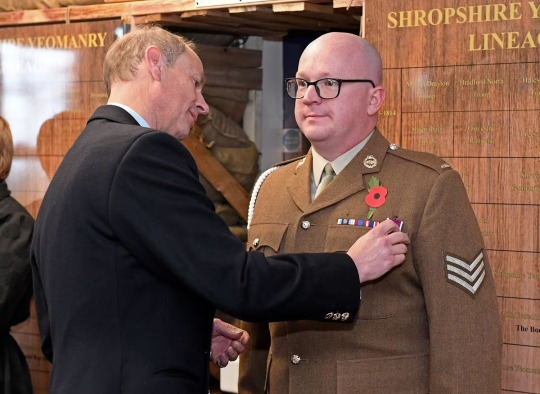
The Duke of Edinburgh presents a Long Service Good Conduct award to Sergeant Joel Edwards.
Mr Bradley, 33, explained how the group could make a difference, saying: "I know first-hand how sports can help towards better mental health. I have been through what I have been through myself so to be part of what Jim has put together has really helped me, so now hopefully I can help others."
Telford Mind provides a Monday Club where veterans can chat and support each other, and the Duke talked to a number of people who attend the sessions.
Mind trustee, Trevor Hirst, who served with the Royal Electrical and Mechanical Engineers (REME), said the Duke had been "funny", "very friendly", and "easy to chat to".
He said: "He asked who I served with and he said he should have recognised from my tie because his wife is a patron of the REME charity."

Cadets giving a gun-run demonstration.
Tom Kane, 65, from Telford, attends the Telford sessions. He came along to the tea party with his dog Harley.
Mr Kane, who spent 30 years in the RAF, said the Duke had asked about Harley.
He said: "He asked what he does for me and I said he tells me when someone is at the door, tells me when the phone rings, and tells me when the missus wants me."
The Duke chatted with the group Models for Heroes – an organisation which allows veterans and people in the services to meet up and build models together.
Gary Morris, who runs the Telford group, was joined by two RAF servicemen who run the RAF Cosford group, Chris King and George Hickish, and other members.
They explained that the Duke had talked about the original Lightning aircraft, saying that when he was at school they would take off and everyone would have to stop talking because the planes were so loud.
Louise Heap, CEO of Telford Mind, said the Duke had asked about what services they provide and how they work, with service manager Jen Caldicott adding: "He just thanked us for the great work we do."
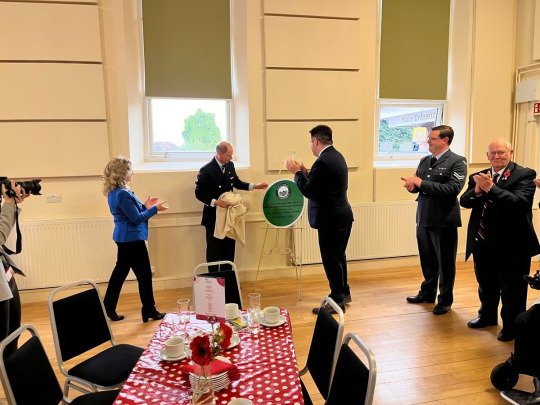
The Duke unveils a plaque marking 150 years of Dawley Town Hall.
Speaking at the conclusion of the visit Councillor Davies said: "It was a real privilege to host the Duke of Edinburgh and to show him first-hand the vital work we do to support the armed services and veterans, it is something we take very seriously.
"He was very personable and able to share not only a story but a joke or two as well.
"And I think everyone who met him at both sites really appreciated his time and effort to come and see us."
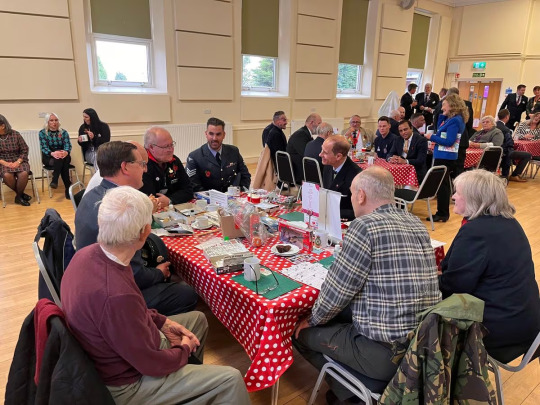
The Duke talks with members of the Models for Heroes groups.
The Duke had earlier attended the Army Reserve Centre – the base of D-Squadron, The Royal Yeomanry.
Local cadets also train at the base twice a week.
During his tour the Duke was given a gun-run demonstration from the Army cadets before they provided a live first aid demonstration.
The Duke then presented an award to 15-year-old Lance Corporal Dylan Fugatt from Ellesmere.
The youngster, who was joined by his mum Sharon for the presentation, was being recognised for using first aid skills learned with the cadets to come to the aid of an elderly man who had fallen over in Ellesmere.
Speaking after the presentation Lance Corporal Fugatt said: "It was a bit of a shock at first. I don't think it has sunk in properly yet."
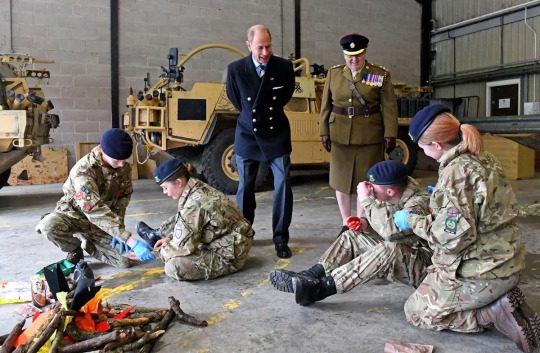
The Duke of Edinburgh was given a first aid demonstration.
He added that the Duke had been "great" and "just like any normal person".
His mother added: "I am so proud. I am very, very proud of how Dylan handled the situation back when it happened but to be recognised in this way, I am more proud for him after his efforts in training, I could not be more proud."

The group were joined by the Duke for a photo at the end of his Dawley Town Hall visit.
The Duke was also shown laser shooting, had a go at tying knots with Navy Cadets, and then saw young Air Cadets trying their hand at flight simulators and virtual reality kit, before presenting a Long Service Good Conduct award to Sergeant Joel Edwards.
#brf#‘should have recognised the tie because his wife is the patron of REME’#I didn’t expect this much anecdote from a local engagement coverage 🥲#oh sweet ed who is so proud of his soph#royal anecdote#ed#prince edward#duke of edinburgh#royal otp
2 notes
·
View notes
Text

"MEET THE FIGHTING HICKSONS AND THEIR GALLANT DIEPPE HERO," Toronto Star. October 2, 1942. Page 14. ---- SERGEANT George A. Hickson of the Royal Canadian Engineers has been awarded the Distinguished Conduct Medal for outstanding valor at Dieppe. Sgt. Hickson's home is in Kitchener.
HIS WIFE AND CHILDREN smile happily at the news of Sgt. Hickson's decoration. Mrs. Hickson is the former Mary Potwarka of Kitchener. George Jr. (left) will be six in December. Larry was four last month.
PROUD PARENTS of the Dieppe hero are Mr. and Mrs. George Hickson. Mr. Hickson is a veteran of the last war. Sergt. Hickson blew in the wall of the casino at Dieppe. blasted the steel door from a gun emplacement. FOUR BROTHERS of Sgt Hickson are also in uniform. Gerald, 17 (above), is in a reserve army unit, while anxiously awaiting his 18th birthday and a call to the R.C.A.F. STAUNCH ARMY MEN are Gordon (left, above) and Robert Hickson, shown with their sister, Mrs. George Bews of Kitchener. Pte. Gordon is training in eastern Canada with the Irish Regiment. Pte. Robert is overseas with the Highland Light Infantry of Canada. Their father served through the last war.
ELDEST brother of the fighting Hicksons, Harry is a flight sergeant in the R.C.A.F., at present serving in Alaska. His home is in London.
#kitchener#royal canadian engineers#dieppe#dieppe raid#royal canadian army#military medal#war hero#war propaganda#royal canadian air force#history of crime and punishment in canada#canadian highland light infantry#irish regiment#canada during world war 2#world war ii
2 notes
·
View notes
Text
Green Lanterns of the 'Modern Age'
Hal Jordan-Spectre
From Coast City, California
Green Lantern during the latter half of the 20th Century, in roughly the same generation as Jade, Obsidian, and Infinity Inc, and Robert Queen, during his work with IO.
So technically he’s Pre-Modern Age
Coast City gets destroyed by Monarch, after which he disappears into deep space.
He returns in the modern age, possessed by Parallax and slaughtering the Guardians and a good chunk of the Corp.
The damage he does leaves the Green Lantern Rings vulnerable to being overtaken by other emotions, leading to a recruitment drive by Sinestro and his Qwardian allies, amongst other factions…
Following his death at the hands of his fellow Lanterns, Sinestro, and the League, he would find himself as the new host of the Spectre.
John Stewart-Mosaic
From Midway City, Michigan (Which takes the place of Detroit), an architect who gained his ring holding off a damaged Manhunter while he was consulting with Ferris Air.
The first “Modern” Green Lantern, and a founding member of the Justice League.
Had a brief Space-Vegas marriage to Katma Tui, though they would eventually settle into a more platonic relationship, and have a romance with Hawkwoman, Kendra Munoz-Sauners.
Following Hal’s rampage, John would be appointed to the position of Guardian, overseeing the GLC during the War of Light and the resulting treaty to form the Mosaic.
Would later override his Lantern Ring with compassion, becoming an Indigo Lantern when the First Lantern escapes.
Loves the alien tech he encounters, wants to take stuff apart to see how it works, reverse engineer alien tech and how it can be modified, how it works with human technology.
Very thorough and blueprint-y construct style, which makes him a little slow by lantern standards but makes his constructs incredibly durable.
Guy Gardner-The Warrior
Actually nonbinary.
Was a social worker before a TBI, is very mad about it.
Opened a bar in Bludhaven, Warriors, and even made some association with Dick Grayson.
Tapped as a back up Lantern by John when he went off world due to their willpower. The other leaguers really questioned John’s judgement on that one.
Still proved their mettle, but gave up the ring surprisingly easy once John was back.
Would still be tapped as a GL and JL reserve, but lose his rings and both arms during the Emerald Twilight.
Would later get metamorphic prosthetics originally belonging to the Vuldarii, a civilization that harnessed the Emotional Lights in a much more raw, untamed form.
Became the Warrior and served with the JLI, harnessing their emotions to power the prosthetics.
Their use of the Emotional spectrum now is flame-like, fast and destructive, but actual Light based constructs have little lasting power.
Kylie Rayner-The White Lantern
Irish Woman here.
Given a GL Ring by a dying Ganthet during Emerald Twilight.
Would spend her career fighting the Controllers, their Effigies, The Third Army, The First Lantern, etc..
Alex DeWitt doesn’t die, but they eventually break up.
Also has a very intense relationship with Soranik Natu, who herself would become the Yellow Lantern representative of the Mosaic.
Ascends to become The White Lantern during Crisis, becoming a guardian of E136’s dimensional barriers.
Her construct style has a sketchy quality to it, and tends to evolve through different “drafts”
Simon Baz and Jessica Cruz-Emerald and Opal
Okay, these two aren’t Green Lanterns per say, but connected to the Emotional Light and Darklands, like Jade & Obsidian (20th century Infinity Inc. heroes, here)
The ring of Volthoom (native to E136 here, a GL ring high jacked by the ancient rogue Emerald Knight, Volthoom of Mars) finds a host in the traumatized Jessica Cruz, sewing chaos as Limelight.
Eventually Jessica gains control of the ring, though it tries to blow itself up.
I explain how that goes (and how Simon enters the story) here.
Simon walks out of the explosion connected to the Light, capable of GL style hard light constructs and healing.
Jessica leaves connected to the Darklands, allowing her to manipulate her shadow like a GL ring, travel through shadows, and see visions.
They fall in with Infinity Inc. at first, but join the JL soon enough, before getting married.
Jo Mullein-Far Flung
Recruited after John’s appointment to Guardianhood, dispatched to Far Sector for a while.
Is recalled to Earth to help teach Stephanie, and ends up as the JL's main Lantern.
Stephanie Brown-Emerald Knight
Spoiler. Robin. Batgirl. Dead. Arkham Knight.
Stephanie actually gets a Red Lantern Ring around Crisis, though overrides it through sheer force of will.
Is partnered with Jo Mullein, and thus the secondary Lantern of the JL, which would see her working with two of her exes.
Keli Quintela-Teen Lantern
Somehow engineered a connection to the Emotional Spectrum similar to Lantetn Power Batteries.
Tai Pham-The Legacy
Descendant of Golden Age GL Kim Tran
Newest Green Lantern as of yet.
Milagro Reyes-Spectrum
Uses a multi colored Spectrum Ring.
1 note
·
View note
Text
#OTD in 1975 – Miami Showband massacre | UVF volunteers (some of whom were also UDR soldiers) shot dead three members of an Irish showband at Buskhill, Co Down.
Three members of the Miami Showband are killed by Ulster Volunteer Force members posing as members of the security forces when returning from a performance at The Castle Ballroom in Banbridge, Co Down. (Four of the killers were actually members of the Ulster Defence Regiment (UDR), an official reserve force for the British army). At the time, the Miami Showband were one of the most popular…
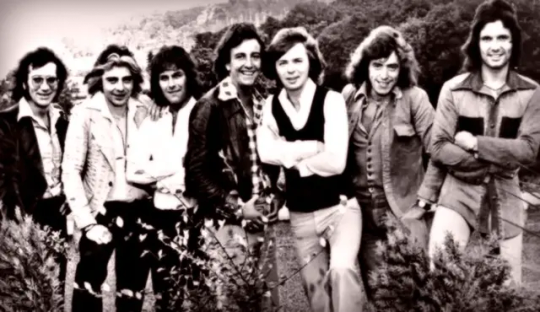
View On WordPress
#Banbridge#Brian McCoy#Co. Down#Dublin#Fran O’Toole#Monument#Parnell Square North#The Castle Ballroom#The Miami Showband#Tony Geraghty#UDR#Ulster Defence Regiment#Ulster Volunteer Force#UVF
9 notes
·
View notes
Text
Cornwall Park History Time Line
Maungakiekie is split into two separate parks: Maungakiekie One Tree Hill Domain is jointly governed by Ngā Mana Whenua o Tāmaki Makaurau and Auckland Council as the Tūpuna Maunga Authority, while Cornwall Park is managed by the Cornwall Park Trust Board.
67,000 years ago Maungakiekie is formed in a volcanic eruption, creating the iconic scoria cone we see today. Walking around the park you will see scoria and basalt rock formed during this eruption.
1844 - Irish settler Thomas Henry purchases 400 hectares of Maungakiekie land from Māori and renames this Mt Prospect Estate.
1847 - The Crown confiscates part of Maungakiekie from Thomas Henry, which is then quarried for basalt and scoria rock.
1853 - Sir John and William Brown purchase Mt Prospect Estate, rename it One Tree Hill Estate and lease it out to farmers.
1870 - 1880 - Sir John establishes the Olive Grove after an unsuccessful attempt to cultivate a winery (11,000 grape vines were initially planted). After removing the vines, 5,000 olive trees were planted, some of which are still growing in the park today.
1871 - The Crown-owned land at the summit of Maungakiekie One Tree Hill is declared a public reserve.
1875 - Sir John plants a young tōtara in the middle of a grove on top of the maunga with five Monterey pine trees around it to act as a windbreak. Unfortunately, it did not survive the harsh conditions. Only one pine remained as the iconic “One Tree” until 2000.
1881 - Sir John decides he is going to give his One Tree Hill Estate to Tāmaki Makaurau Auckland, later gifting it to the whole of Aotearoa New Zealand.
1901 - The One Tree Hill Estate is renamed Cornwall Park after the Duke and Duchess of Cornwall and York in honour of their visit to Aotearoa New Zealand in 1901. It was officially gifted to the people of Aotearoa New Zealand in 1901, but it will take two more years before the park is open to the public.
American landscape architect Austin Strong works closely with Sir John to create a park plan and landscape design to be enjoyed by all New Zealanders. The design of the sweeping tree-lined drives leading through the park was planned from the very beginning, providing access and amenities whilst highlighting the natural beauty of the slopes of Maungakiekie.
1903 - On August 26th, Huia Lodge and Cornwall Park are open to the public. Huia Lodge is built in the Queen Anne Revival style to house the park caretaker and serve as a stop-off point for visitors making their way to the tihi (summit) of Maungakiekie. The front room was designed as a tea parlour for visitors, with refreshments served on sunny days.
1906 - On May 24th, the people of Tāmaki Maukaurau Auckland pay by public subscription for a statue and water fountain of Sir John Logan Campbell to be placed in the middle of Campbell Crescent.
1907 - Sir John gifts an additional 41.6 hectares of adjacent land to the park.
1908 - A further 57.6 hectares are added to the parkland and the kiosk (now the Cornwall Park Bistro) is constructed.
1912 - On June 22nd, Sir John passes away aged 94. A small section of land is transferred to the park trustees atop Maungakiekie for his burial site.
1926 - The Cornwall Park Trust Board employs Farm Managers to form the Cornwall Park farm on areas previously leased to independent farmers.
1940 - Sir John bequeaths the obelisk at the Maungakiekie summit in honour of the Māori people. It is completed in 1940, but due to World War II, it was decided that the opening ceremony would be postponed according to Tikanga Māori which states it is inappropriate to unveil a monument during a time of bloodshed. The ceremony eventually took place on April 24th 1948 and was unveiled by the Māori King, Koroki.
1942 - 1944 - The US Army 39th General Hospital is built within the park for American soldiers.
1956 - The Memorial Steps are constructed as a memorial to Sir John.
1986 - 1988 - After the hospital was demolished, the land was returned to Cornwall Park and restored and developed for use by the public. Trees are planted, and the Band Rotunda is built.
1990 - Simmental cattle are introduced into the park.
2000 - On October 26th, the lone pine on Maungakiekie One Tree Hill is removed after being attacked several times over the century, as it became a health and safety risk to allow it to remain.
2016 - Three tōtara and six pōhutukawa saplings are planted at the summit of Maungakiekie to begin the process of growing the hills next "One Tree."
Cornwall Park. "Cornwall Park Timeline." Cornwall Park. Accessed October 3, 2024. https://cornwallpark.co.nz/history/cornwall-park-timeline
0 notes
Text
Best Briar Pipe For Beginners
Best Briar Pipe For Beginners
I am often asked by beginners about the best pipe selection as a passionate pipe enthusiast. For those who are just starting out with pipe smoking, it is important to choose a good briarwood pipe that will allow you to enjoy the full flavor of tobacco.So in this blog post, I will discuss the best briar pipes for beginners and list their features. If you are a beginner curious about pipe smoking, I sincerely suggest you read on. Let's take a look!

MUXIANG Holmes Briar Gourd Pipe

This Sherlock Holmes Calabash Pipe takes inspiration from the traditional Calabash gourd pipes, with its bowl meticulously carved out of fine briarwood to create a spacious secondary smoke chamber. This allows the smoke to cool and condense before entering the stem, delivering an exceptionally smooth smoking experience.The voluptuous calabash-shaped bowl flaunts a beautiful honey-blond finish, showcasing the flowing golden grain patterns of premium briar. It is sanded and polished to a sensuous satin sheen. The rest of the stummel is covered in a contrasting dark caramel lacquer, making the blond bowl pop out gorgeously. Intricate linear textures run along the sides, culminating in a magnificent bird's eye pattern on the front and back.The extended briar shank is adorned with a short horn ring, adding a classic finishing touch. It joins a slender saddle stem of hand-crafted vulcanite, ergonomically angled downwards for comfortable smoking. This contrasts and stabilizes the opulent bowl perfectly.
Sherlock Pipe With A Colorful Acrylic Mouthpiece

Although I have over 100 handmade briar pipes, this Holmes Briar Gourd Pipe is one of my favorites in my collection.MUXIANG's latest Holmes Briar Gourd Pipe is a seamless blend of Danish style and classic English-Irish shape designs. Crafted entirely from briar, the pipe takes its silhouette inspiration from the traditional Holmes form, while the curved bowl exudes Danish elegance and fluidity. The sweeping transition of the bowl is especially outstanding, lending depth to the expansive chamber. As a whole, the robust size and sturdy proportions retain MUXIANG’s penchant for hearty shapes, yet the smooth lines inject a touch of Scandinavian flair. But with a twist - the mouthpiece is made of swirled acrylic in eye-catching colors like blue, purple, or green. The acrylic not only adds visual appeal, but it cools the smoke for a smoother hit.Beyond the graceful exterior, the deep bowl promises excellent smokeability and the pipe fits nicely in hand. It retains the understated earthiness of traditional English-Irish style while incorporating the soft roundedness of Danish influences. MUXIANG’s master craftsmanship ensures an open, even smoke path, marrying exotic flair with time-honored techniques. This Holmes pipe offers pipe aficionados a beautifully novel visual experience and smoking enjoyment.
Peterson Dublin Filter series

Peterson has explored filtered pipe forms since 1947, and the Dublin Filter series has comprised their filtered offering since 1997. In 2021, the Army Filter line expanded the selection, each pipe drilled to fit a 9mm charcoal filter. Typically, when a maker releases filtered versions of classic shapes, some designs get altered for wider drilling. However, Peterson's robust shanks and transitions facilitate seamless crossover between filtered and non-filtered versions. The Dublin Filter pipes retain a reserved, timeless look in traditional mahogany tones with twin nickel ring accents.All pipes across this series are drilled for 9mm filters, paired with Peterson’s patented charcoal filters (150 and 40-count boxes). Peterson’s sturdy shank design facilitates seamless transitions between filtered and non-filtered iterations of the same shape. The Dublin Filter series exhibits Peterson's trademark stout shanks and muscular aesthetic while remaining refined. These pipes showcase Peterson’s skillful balance of distinctive style and classic pipe standards.pulvinar dapibus leo.
Punto Oro Savinelli

Just below their top-of-the-line Giubileo D'Oro series, the second finest quality line of traditionally shaped pipes produced by the Italian pipe manufacturer is the Savinelli Punct Oro series. Though it may still have some little defects unlike the perfect Giubileo D'Oro, the Punto Oro has a far superior briar quality and general workmanship than standard Savinelli pipes. The Punto Oro is a more premium smoking experience than traditional Savinelli pipesThe most noticeable improvements in Punto Oro are in cosmetic details that show off Savinelli’s artisanal skills. This includes smoother lines, a higher gloss finish, minimal briar imperfections, and an elevated level of staining and polish work to highlight the briar’s mesmerizing grain.Take the Punto Oro 106 Billiard, a thin variation on the traditional Billiard form. Its graceful dimensions highlight the differences between bowl and shank, and its deep burgundy stain influenced by wine accentuates the whorls and patterns of briar.Collectors greatly value Punto Oros as just 2% of all Savinelli pipes make it there. It is the height of Savinelli's creativity on conventional English and French pipe shapes. The Savinelli Punct Oro is a top choice not to be overlooked for pipe enthusiasts seeking outstanding beauty and workmanship within classic pipe paradigms. Read the full article
0 notes
Text
youtube
"Spiral":
Masterminds Dispatched:
NSA Admin: Lincoln Chaffey.
"Max".
The molestation of minors as bit for radio pranks, for NEC Comics; the Rhode Island PD's mechanism for refusing officers having matched a print villain, however "The Tick" is the writer's staff, a male pedophile in cause of found to have beaten his wife with physical knuckles of the rear of hand.
UMass-Amherst CI: Scott Peterson.
"Batman Begins".
The attempt at fraud of United States election through MI-6 NSA HUMINT in refusal of potluck, police; the Irish Provisionals, the United States civil services. The found nominal as having promoted an Amish marriage, for transition of ICBM stocks, outside of MI-6 Gentile stock into American Judaism, to betray Britain for Canadian independence in Parliament and an end to the Orange Order of Zulus and their Friendkin.
Air National: John McCain.
"Sons of Anarchy".
The funding to the Church of Satan as an officially registered denomination of domination, mandatory for all Romalians to join, under auspice of leadership of Brian Warner, alias Marilyn Manson, and an end to the refusal of the gay precipice of claim, from that provoked of agency of Romalian.
Homeland Security: Queen Elizabeth II.
"SPECTRE".
The Boston terror bombings, to hide involvement of her grandson, Crown Prince William, prior the office held by Charles III, to prevent amnesty being removed for all Latinos, Africans, or Romalians; the turning of national benevolence, of Saudi Arabia, into ire, at the framing of Chechnyan national allies of Saudi Arabians into a pro-Israeli position unwanted and against Saudi-Jewish identity.
DC Comics: Benjamin Netanyahu.
"Gotham".
The doom of Jews to factory jobs and warehouse labor, at the hands of MENSA, the Mormon faith of found prostitutes having wed and in dismissal of drug and prostitution; unnecessary, already an American police position, however in refusal of African-Americans, essential parts of Washington, Madison, Johnson, Grant, Garfield, and Cleveland, as well as supported by Franklin Delano Roosevelt, as housing for Germans to merge with African lines, to forgive the Holocaust of the Irish.
Army Reserve: Donald J. Trump.
"Fool's Paradise".
The sabotage of American markets to favor the Japanese intelligence services, to pay own daughter, Ivanka, for her police service, at having defaulted on loan to his very own name, due to service in the World Wrestling Federation; Vince McMahon's merger, with the World Wildlife Federation, to produce Atavan; the terrified cat's death, to produce adrenochrome, for management of grocer's unions outside of proper rearing of local town tradition, instead siding with large chains to produce law professors of improper ilk outside own honesty of origin logic. Using film, instead.
NSA HUMINT: Kim Jong-un.
"Assassin's Creed: Syndicate".
A fitting challenge, from an old friend. Webb, would you take Angus, by pale deviled moonlight?
0 notes
Text
It is not often—nay, it has never happened—that Artemis has agreed to go on a blind date. Even moreso, it was infinitely less likely that such an affair would go in a direction that was even slightly positive. Perhaps Dionysos had been onto something—Aisling, as Artemis had come to know the woman, was no standard mortal. A newly christened immortal, she now walked among the inhuman, and apparently... that also meant being privy to their love lives, as well. It was no secret that the Olympians had a long and sordid history with these things—Artemis was mostly exempt from that, given her preference for privacy and discretion—so to think that Artemis had even agreed to a blind date like this was monumental. Despite whatever reservations she may have held, the night went... well. Very well. Artemis held no qualms; it was enjoyable, and although Aisling seemed to enjoy the mundane aspects of her life, perhaps there was joy to gleen from that, as well. Under the rays of steady moonlight, outside in the cold air of the pavilion Dionysos had arranged (thanks in particular to his endless army of lovestruck nymphs), the goddess found that she did not wish for this night to end quite yet. She held a half-filled bottle of wine (conjured at her behest) loosely in her hand. With a light touch of Aisling's knuckles, she aided her in raising the crystal wine glass she held so that she could refill it once more. "And where do you think you will be going, after this?" Artemis asked lightly, her silver, reflective gaze focused upon the dark liquid. She glanced up to survey Aisling's expression with a faint smile, a hint of amusement in this song and dance. Oh, how it never changed—but the delight remained all the same.
mcdonalds would be a palace if artemis were near it. aisling figures that's the goddess in her. but that said, she's met a good few of the deities since that fateful choice on vormir. the allure of immortality. so few immortals wander this planet, it makes sense that they'd be drawn to one another. and yet, artemis is light-years ahead of the others. something in the absence of condescending pity when she asks aisling about the domestic elements of her newly transformed life. in the way @epistrefei interacts with a world that should feel as small as a grain of sand to one as impossible as herself.
she accepts the wine, but sets it aside so she can address her properly. the wine is admittedly nicer than most of the ones she's tasted, but she wonders if she's just not destined to be a vineyard owner at this rate. that said, she has an eternity to develop a taste for the stuff.
" after this date? there's a ceíli in a street near the diner. the whole street is lined with irish businesses, but it's not for tourists. just something that we do here to match the event in ireland. i might take a detour to see it, if you want to join me? " she reaches for the glass again, though this time she just turns it to watch the lights twinkle in the crystal. the smile lingers, though fading to something a touch more melancholy as the unfriendly thought of the future approaches her once more. " in terms of the long-term... seems i have plenty of time to come up with plans. "
#epistrefei#( v 001: the land of dreams. )#( AH!!!!!!! THIS TOOK FOREVER BUT HI ILY )#( THIS HAS MY BRAIN ENRAPTURED RN )#alcohol mention tw
1 note
·
View note